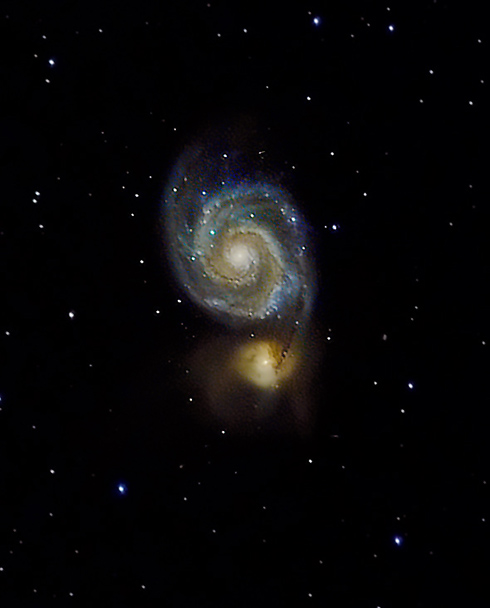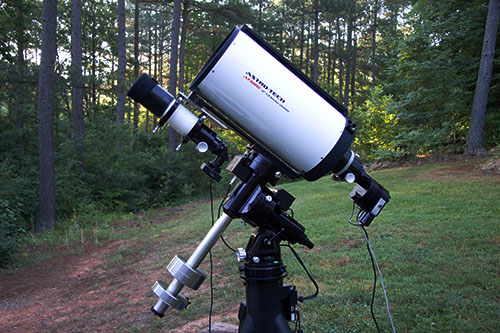|
6/06/2011. Clear skies all day, then patchy clouds at the end of twilight. I had time to line up on M51 and focus but not to calibrate the guider before the lid came down. I came inside, worked on a few projects on the computer, and kept my eye on what the guider saw. Whenever the bright star E of M51 came up out of the murk, I attempted to calibrate the guider. On the fourth attempt, I succeeded then went outside to compose the frame in the ST2000. This time, instead of putting the 7th magnitude star that lies 20 arc minutes east of the galaxies just outside the frame, I aimed so that the guider could use it. It's cropped out of the image shown here. If clouds move in again tonight, I'll have some chance of guiding through them.
M51 with SN 2011dh
This subject reminds me that I really need more reach and more light-grasp for most galaxies. I've toyed with designs for rebuilding the 10-inch. In fact, a used Tectron focuser arrived today for that nascent project, but it may find a better home on the dob in the basement which was built, afterall, along the lines of Tom Clark's instruments. Using the Meade SN10 will only increase my available FL from 762 to 1000mm while reducing my F-ratio from 6 to 4. Thinking, shopping, and thinking some more... I am vulnerable to a good deal along about now. Also as of now, I have 9 five-minute subs in the can. Seeing is better and transparency is worse than my previous attempt. As usual, I plan to let the telescope roll overnight and see what prizes it has collected in the morning. As long as it doesn't collect rainwater, I'll call it a good deal. Does the SN look a little brighter tonight? Maybe. Maybe not. It wouldn't be at all surprising if this one were still on the rise: it's bright and in a well-watched galaxy so if any are caught on the rise, this one should have been. Wait a few nights, gather a few more images every chance you get, and try out the photometric stuff recently worked out for exoplanets.
6/09/2011: I kept thinking about that 10-inch mirror and how best to put that much aperture to work. Read, made notes, squinted at equipment and reviews. Can a Mach1 carry an AstroTech 10-inch RC at F8? There's some lovely work out there with that combination, but two photographers say the Mach1 seems nearly maxed out. Roland has no doubt it can carry an AT12RC (which is naturally considerably heavier and longer than the AT10RC) and "up to a 14-inch RC" though whose and with what accessories I'm not sure. Does the AT10RC need a flattener with my relatively small ST2000XM chip, and will the A-P CCD 0.67x compressor work? Could I machine an adapter for the A-P 0.75x I've used for years? Some say there are lots of flatteners and a variety of compressors, others say that none are worth a damn and others "do not work" with the telescope, presumably because of backfocus issues. Everybody agrees that collimation between the two hyperbolic mirrors is critical in all R-C's; some say it's easy, others say it's a tough nut. OK, lookit. Highpoint Scientific -- fiscal descendents of much loved and often missed Pocono Mtn Optics -- has their floor demo model for sale, free shipping, no tax, full warranty, 25-30% off typical street prices. Let's see what this is all about.
Note: Jared Wilson has tuned his Mach1 / AT10RC combination to the nines and has much good advice. On CN, he notes that with a 200mm FL guide scope he's getting 2.1" PSFs vs 1.9" using an OAG. Even that slight advantage, he says, might be an accident of seeing. This makes me feel much better about my 400mm guider. Another CN commentor mentions hanging his 50mm guider off the front underside of his AT8RC, so that notion does have promise; I set up the bracketry on the guider to facilitate that geometry, but I'll just have to put it on the mount and see if there is room for the guide camera to clear the Mach1's motor housings in all parts of the sky. In a photo of his rig, Jared appears to be using an OAG with one 5-pount and one 18-pound counterweight on the same extended counterweight bar I'm using. He has some room to spare on the 5 pounder. I have 10 and 18 pound weights with plenty of room to spare when using the A-P 5". I think they will suffice, especially if I can sling the guider low. Project for tomorrow: make a handle using the Losmandy dovetail clamp that rode with the 10" Meade SN optics on the "lobster-trap" telescope. It will become a grapple gripper that can be attached to carry the Ritchey and A-P to and from the mount and then be easily removed. Also, make a new grip for the broken clamp nut.
6/10/2011. Some days you just don't want to do anything complex. Before breakfast, I cleaned up around the lathe; after breakfast, I turned a new knob for the Losmandy clamp, drilled and tapped a hole for a set screw to lock it in place. Then things went south. Went to Lowe's for appropriate 10-24 bolts and a handle; got home and found that the bolts were the perfect length, but I'd picked out 1/4x20's. I made do with 4 overlong 10-24's and hacksawed them to length. While cutting the third bolt, the saw blade broke. I finally got the handle bolted up securely and decided to paint it the official color of righteous astronomical tools: black. Ran out of propellant 3/4's the way through. Maybe I'll leave the Ritchey inside for one more night. Seems safer that way. Rain is in the forecast and stars are murky. 6/12/2011. The grappler works great. I used it to bring the 5" A-P inside, then used it to carry the AT10RC outside. Before mounting it on the Mach1, I moved 28 pounds of counterweights to the end of the extended bar. Then I put the CCD behind the 'scope (both are pretty well useless otherwise) and put the DSI/ST80 guiding package up top. As expected, this arrangement needs another counterweight. A ten pounder would do. I moved the guidescope to the bottom rail. There is plenty of room for the guide camera to clear the motor housings with the guider mounted about as far forward as possible which means there is some room to experiment. The 28 pounds of counterweight is plenty with the guide scope mounted low. In fact, I moved the weights about six inches up from the end of the extended bar to find the best balance. This combination is not as rock-solid as the Mach1 / 5-inch combination (no surprise there). It's clear that I need to keep the moment arms as short as possible. Damping is relatively slow. Wind will matter. With that in mind, I redrilled the mounting plate for the guider and put the 1.25-inch diagonal back into its optical path. Both adjustments let me move the guide-scope down from the end of the OTA. Better. It also means I can use the ST80 as a visual finder since it brings the focus out to the side. Since I am not using the top plate, I could remove it and save a few pounds some distance from the CG. Might be worth doing, but maybe its presence contributes to the rigidity of the tube; maybe I'll end up with the guider up there afterall -- maybe, maybe, maybe. The fewer mods I make before first light, the better. The aluminized mylar telescope cover still fits well. Now we're just waiting for dark...
|
:: top ::
© 2011, David Cortner

 I've modified the attachment hardware of the quiding set-up to swap it out as needed (the moveable bits -- ST80, rings, GSO focuser, Meade DSI, aluminum plate, and a single Losmandy clamp -- weigh 7.6 pounds). Put that on top of the AT and I bet I'll be short of counterweights. If it could be slung under the AT, better. Experiments are in order. I also researched available off-axis guiders to save weight and get more precise guiding while still guiding ahead of filters and preserving my favored software suite. I would miss having the ST80 to serve as an electronic finder, since I think aiming will be tougher at this longer focal length (2000mm vs 762mm). If the guidescope doesn't perform as needed, then before laying out cash for an OAG, try the secondary guide chip in the ST2000XM. I have my doubts about the practicality of Ha imaging with the guider behind the filter, but the price is right. Stay tuned.
I've modified the attachment hardware of the quiding set-up to swap it out as needed (the moveable bits -- ST80, rings, GSO focuser, Meade DSI, aluminum plate, and a single Losmandy clamp -- weigh 7.6 pounds). Put that on top of the AT and I bet I'll be short of counterweights. If it could be slung under the AT, better. Experiments are in order. I also researched available off-axis guiders to save weight and get more precise guiding while still guiding ahead of filters and preserving my favored software suite. I would miss having the ST80 to serve as an electronic finder, since I think aiming will be tougher at this longer focal length (2000mm vs 762mm). If the guidescope doesn't perform as needed, then before laying out cash for an OAG, try the secondary guide chip in the ST2000XM. I have my doubts about the practicality of Ha imaging with the guider behind the filter, but the price is right. Stay tuned.